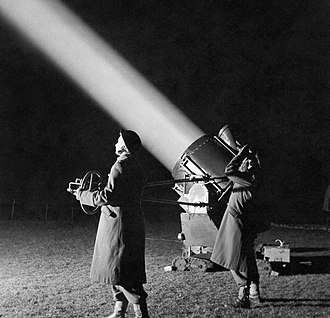Searchlight
Searchlight is a device used to emit a powerful light beam in a particular direction. It is commonly used for navigation, security, and search and rescue operations. The concept of the searchlight dates back to the 19th century, with significant advancements occurring over time, particularly in the fields of optics and electrical engineering.
History
The development of the searchlight can be traced back to the late 1800s, when electricity began to be used as a power source for lighting. Early searchlights used carbon arc technology, which produced a bright light by maintaining an arc between two carbon rods. These early models were primarily used in military applications, for signaling and illuminating targets at night.
Design and Operation
A typical searchlight consists of a powerful light source, a parabolic reflector to focus the light into a beam, and sometimes lenses to further direct the beam. The light source in modern searchlights can be an incandescent bulb, halogen lamp, or more recently, LEDs (Light Emitting Diodes) and laser technology. The parabolic reflector is designed to reflect light rays from the source in parallel lines, creating a concentrated beam of light that can be projected over long distances.
Applications
Searchlights have a wide range of applications across various fields:
- Military: Historically, searchlights were used to spot enemy ships and aircraft during nighttime operations. Today, they still serve in defense and surveillance roles.
- Maritime: In navigation, searchlights are used by ships to signal each other and to illuminate the sea ahead during night operations or in poor visibility conditions.
- Security: Fixed searchlights are often installed in prisons, border areas, and at other high-security locations to detect unauthorized movements at night.
- Search and Rescue: Searchlights play a crucial role in nighttime search and rescue operations, helping to locate lost or injured individuals in challenging environments.
- Entertainment: Searchlights are also used in the entertainment industry, often to create dramatic effects or to signal the location of premieres and special events.
Technological Advancements
The evolution of searchlight technology has been marked by improvements in light sources, energy efficiency, and control systems. The transition from carbon arc to halogen, and then to LED and laser technology, has significantly increased the brightness, range, and durability of searchlights. Additionally, modern searchlights can be equipped with computer-controlled motors, allowing for precise and automated movement.
Conclusion
Searchlights remain an essential tool in many areas, from enhancing security and safety to aiding in navigation and creating visual spectacles. The ongoing advancements in technology promise to expand their capabilities and applications even further.
Transform your life with W8MD's budget GLP-1 injections from $125.
W8MD offers a medical weight loss program to lose weight in Philadelphia. Our physician-supervised medical weight loss provides:
- Most insurances accepted or discounted self-pay rates. We will obtain insurance prior authorizations if needed.
- Generic GLP1 weight loss injections from $125 for the starting dose.
- Also offer prescription weight loss medications including Phentermine, Qsymia, Diethylpropion, Contrave etc.
NYC weight loss doctor appointments
Start your NYC weight loss journey today at our NYC medical weight loss and Philadelphia medical weight loss clinics.
- Call 718-946-5500 to lose weight in NYC or for medical weight loss in Philadelphia 215-676-2334.
- Tags:NYC medical weight loss, Philadelphia lose weight Zepbound NYC, Budget GLP1 weight loss injections, Wegovy Philadelphia, Wegovy NYC, Philadelphia medical weight loss, Brookly weight loss and Wegovy NYC
|
WikiMD's Wellness Encyclopedia |
| Let Food Be Thy Medicine Medicine Thy Food - Hippocrates |
Medical Disclaimer: WikiMD is not a substitute for professional medical advice. The information on WikiMD is provided as an information resource only, may be incorrect, outdated or misleading, and is not to be used or relied on for any diagnostic or treatment purposes. Please consult your health care provider before making any healthcare decisions or for guidance about a specific medical condition. WikiMD expressly disclaims responsibility, and shall have no liability, for any damages, loss, injury, or liability whatsoever suffered as a result of your reliance on the information contained in this site. By visiting this site you agree to the foregoing terms and conditions, which may from time to time be changed or supplemented by WikiMD. If you do not agree to the foregoing terms and conditions, you should not enter or use this site. See full disclaimer.
Credits:Most images are courtesy of Wikimedia commons, and templates, categories Wikipedia, licensed under CC BY SA or similar.
Contributors: Prab R. Tumpati, MD






